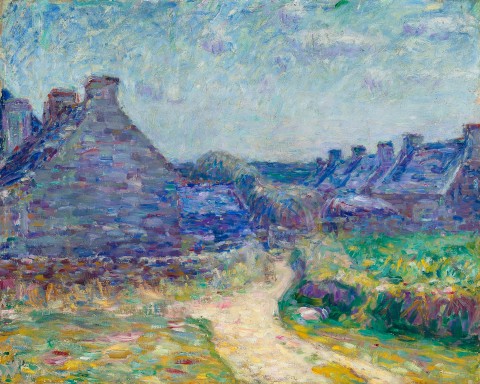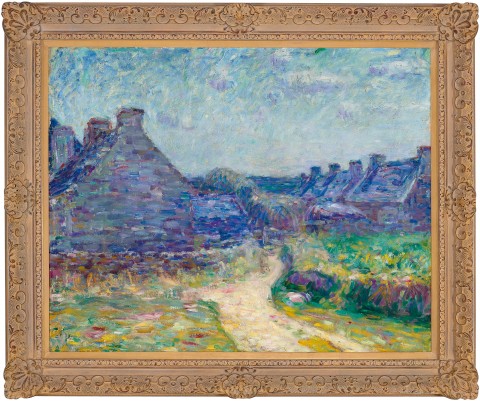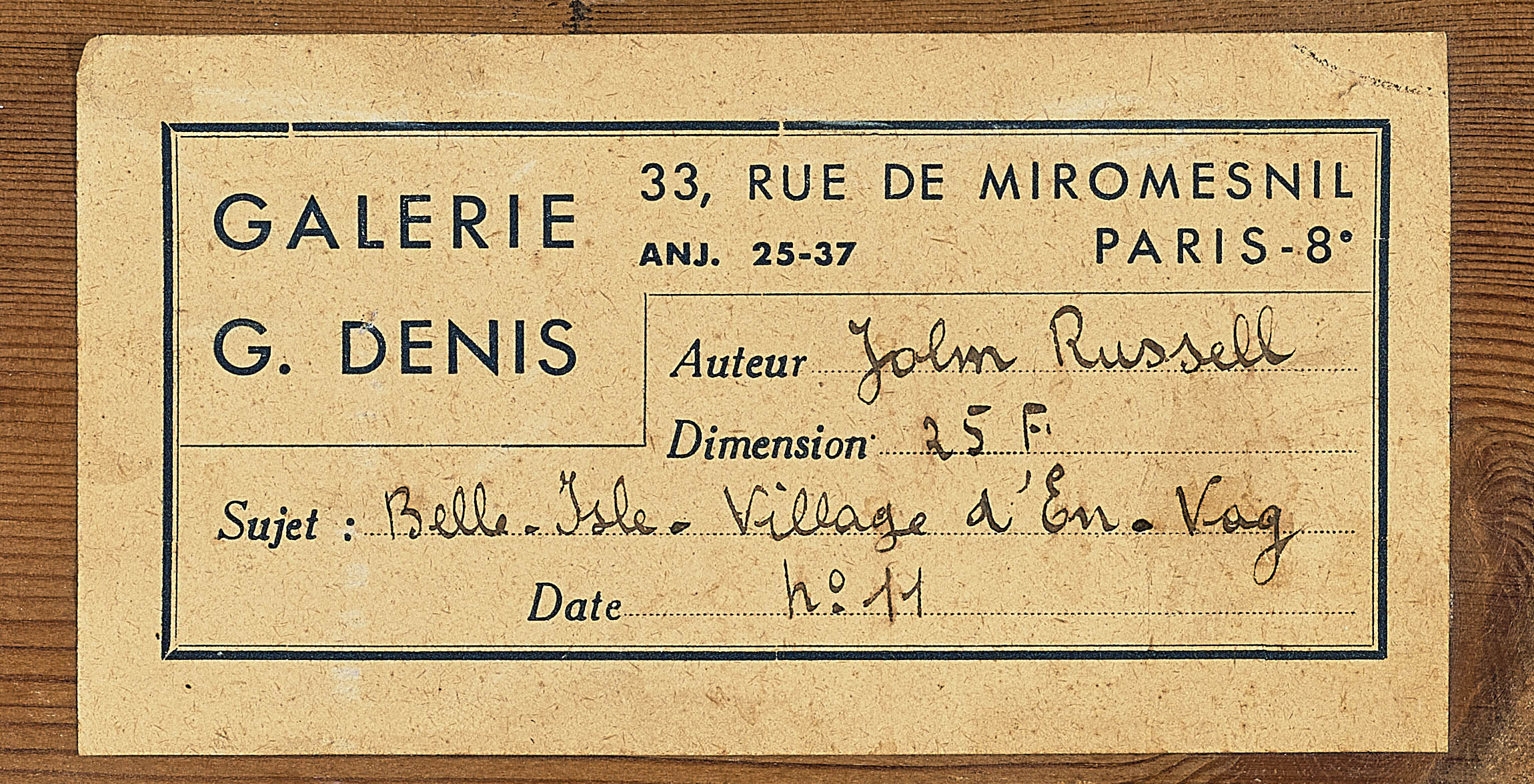BELLE-ÎLE. VILLAGE D'ENVAG [SUNSHINE SHIMMER], 1900
JOHN PETER RUSSELL
oil on canvas
65.0 x 81.0 cm
signed with initials lower centre: J.R.
dated and inscribed with title verso: Sunshine Shimmer / August / B Isle 1900
Estate of the artist, Brittany, France
Harald Alain Russell, the artist’s son, Brittany, France, inherited from the above c.1930
Thence by descent
Private collection, United Kingdom
John Peter Russell, Galerie G. Denis, Paris, 1941 / 1943 (?), cat. 11 (label attached verso, as ‘Belle-Isle. Village d’En-vag’)
On long term loan to Glasgow Museums & Art Galleries, Kelvingrove, Scotland, 1974 – 1991
Galbally, A., The Art of John Peter Russell, Sun Books, Melbourne, 1977, cat. 158, p. 107 (as 'Belle–Île. Village d'En–vag')
Although he was born in Sydney, John Russell lived much of his adult life in Europe and holds a unique place within the history of Australian art for his close association with avant-garde circles in 1880s Paris and firsthand acquaintance with some of the masters of European Impressionism and Post-Impressionism. Following studies at the Slade School, London in 1881, Russell attended Fernand Cormon’s atelier in Paris in the mid-1880s, working alongside Émile Bernard, Henri de Toulouse-Lautrec and later, Vincent van Gogh, with whom he established an enduring friendship.1 On a summer break from Paris in 1886, he spent several months on Belle-Île, one of a group of small islands off the coast of Brittany which, buffeted by almost constant westerly winds blowing in from the Atlantic Ocean, is part of the accurately named La Côte Sauvage. Captivated by the rugged landscape and the possibilities of this environment for his painting, Russell bought land there the following year. Writing to his friend, Tom Roberts, he said, ‘I am about to build a house in France. Settle down for some five years. Get some work done. It will be in some out of the way corner as much as a desert as possible.’2
Gustave Loiseau book image cmyk copy.jpg
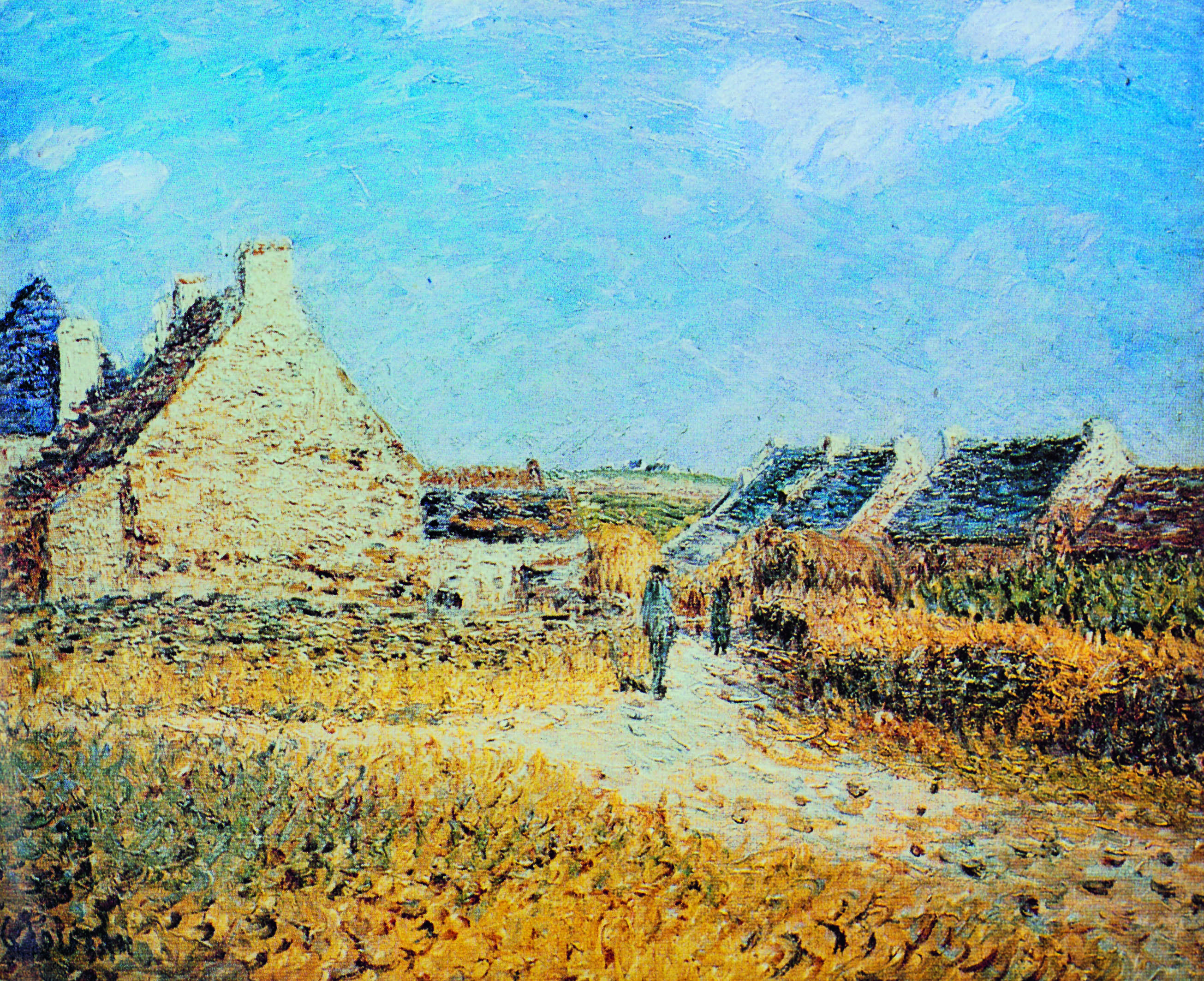
It was here that he met and befriended Claude Monet who he saw working en plein air and, recognising his painting style, famously introduced himself by asking if he was indeed ‘the Prince of the Impressionists’. Flattered, Monet, who was eighteen years Russell’s senior, took a liking to the young Australian and dined with him and his beautiful wife-to-be, Marianna, enjoying their hospitality and company during his stay on the island. Uncharacteristically, Monet allowed Russell to watch him work and on occasion, to paint alongside him, experiences that provided the younger artist with an extraordinary insight into the techniques and working method of one of the founders of the Impressionist movement. The influence on Russell was significant and the paintings he made in Italy and Sicily only a few months later show him working in a new style, using a high-keyed palette (from which black had been banished entirely) and his compositions made up of strokes of pure colour.3 In addition to showing him how to use colour as a means of expressing a personal response to the subject, Monet’s example also highlighted for Russell the importance of working directly from nature.4
French Viilage Post Card cmyk copy.jpg
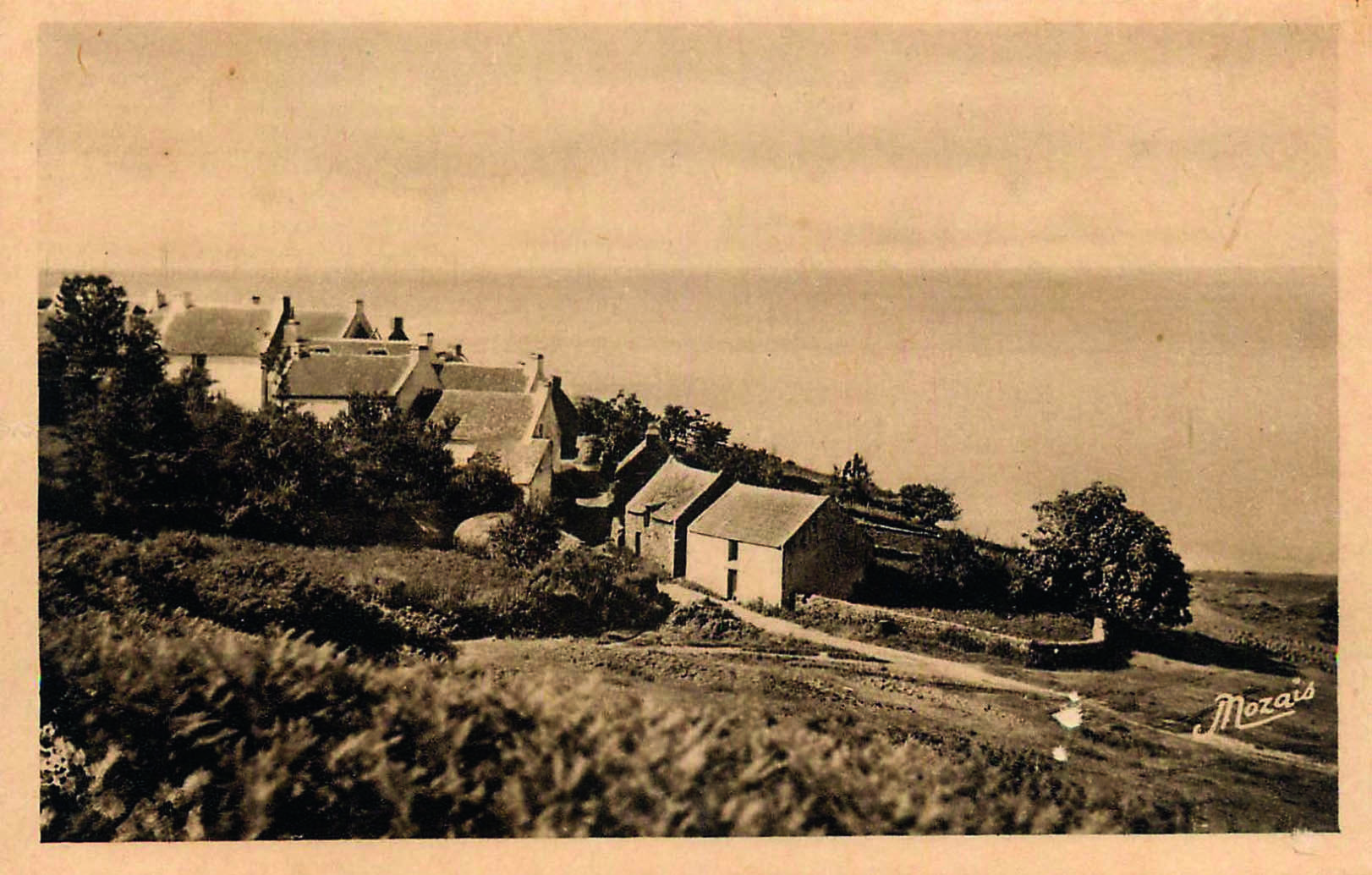
Belle-Île-en-Mer, Brittany, France
Belle-Île offered little in the way of obvious picturesque views but ‘instead … the challenge of a raw confrontation with nature for which there was no tradition of painterly representation.’5 Russell and Monet were not the only artists attracted by its creative possibilities. The roll call of artists who visited Russell and his wife – Fernand Cormon (1888); John Longstaff (1889); Dodge MacKnight (1889, 90, 91 and 92); Eugène Boch (1890); Bertram Mackennal (1891) and Auguste Rodin (1902) – is mirrored by those who came to paint on the island independently. Henri Matisse first visited Belle-Île in 1895 as a young art student, returning in 1896 and again the following summer. Of the island he said simply, ‘Here it is wildness in all its beauty and emptiness.’6 During an extended stay in 1896 he lived at the village of Kervilahouen on the south-western side of the island, near Russell’s house, and the two artists met. Russell introduced the young artist to Monet’s techniques and the work of van Gogh, contributing to a dramatic transformation in his approach to colour. Matisse’s biographer, Hilary Spurling, describes this as ‘a way of seeing: the first inklings of the pursuit of colour for its own sake that would draw in the end on his deepest emotional and imaginative resources.’7
Monet_-_The_Customs_House_at_Varengeville,_1897 cmyk copy.jpg
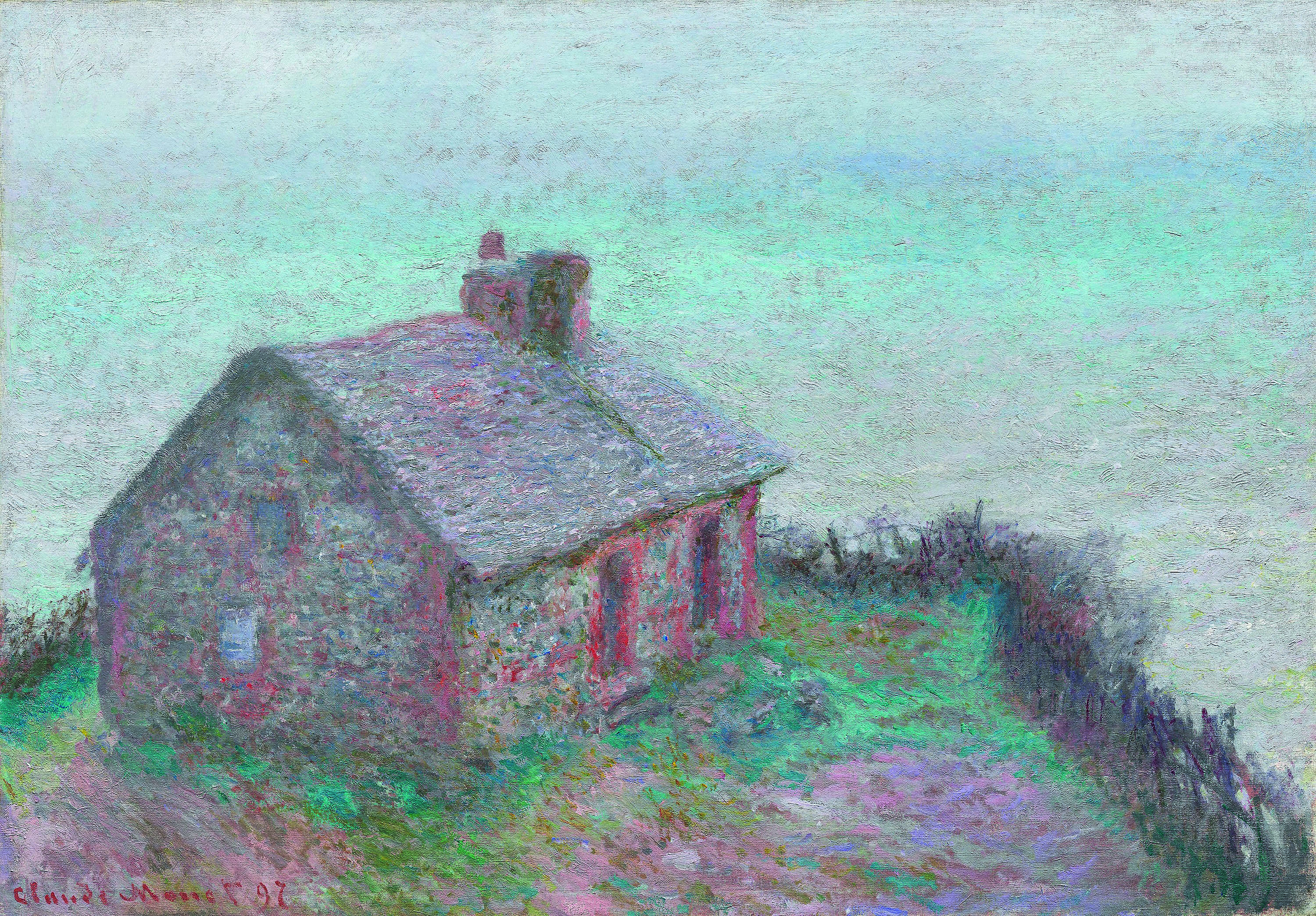
In Belle-Île, Village d’Envag, 1900, it is the distinctive stone cottages of the island, specifically the nearby village of Envag, that have captured Russell’s attention. With a series of chimneys lined up in silhouette against a pale blue sky, the cottages are described in delicate shades of purple, blue and occasional pink and white highlights. Characteristically, the colour is built up in individual brushstrokes which shimmer with movement and light, communicating as much about the appearance of the scene as the feeling of being there. Russell varies the application of paint according to the subject, with regular, mostly horizontal strokes defining the geometric form of the buildings, and freer, more painterly daubs delineating the verdant foreground and atmospheric sky. This is an intimate scene, a local view, and located just north of Russell’s home – known to the locals as Château de l’Anglais – which overlooked the inlet of Goulphar, it was an area with which he was very familiar.
Matisse 2 cmyk copy.jpg
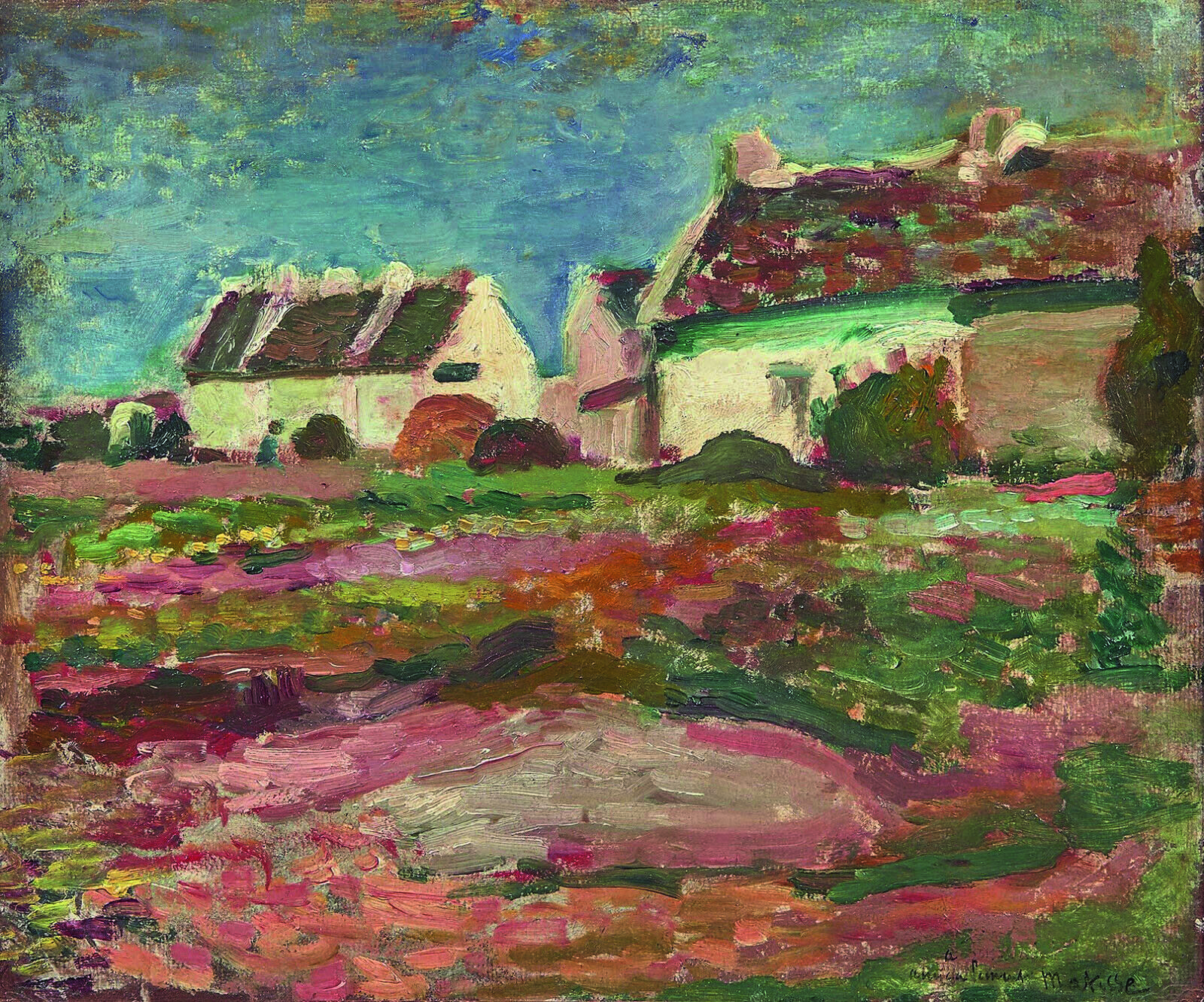
Russell scholar Ann Galbally explains the appeal of a rural lifestyle for many French artists during the late nineteenth century as ‘something that seemed to… be purer, simpler, and more fundamental’ than the intensity of the artworld centre of Paris.8 Citing, among others, van Gogh at Arles, Gauguin at Pont-Aven and Russell at Belle-Île, she explains that ‘they were drawn … towards a primitive life style, a closer communication with nature, a chance, so they felt, to find the source of art.’9 In this context, paintings like Belle-Île, Village d’Envag sit alongside Russell’s images of local fishermen and other island inhabitants, celebrating the simplicity and authenticity of rural life. Monet had painted examples of vernacular architecture in Varengeville, a coastal town in Normandy, and the cottages of Belle-Île appealed to other artists who visited the island. Matisse, for example, focussed on buildings at nearby Kervilahouen which, in the work illustrated here, gleam a brilliant white against his bold colour palette. Probably having seen Monet’s paintings of Belle-Île, the Post-Impressionist, Gustave Loiseau, travelled there with friends and fellow artists Maxime Maufra and Henry Moret in 1900. It is not known whether Loiseau and Russell met at the time, but the similarities between their paintings, both depicting the same area in Envag, make this a tantalising possibility. Russell paints from a position close to the cottages while Loiseau adopts a broader view – the varied perspectives, perhaps, of a local, more interested in capturing an impression of a familiar subject, versus a visitor, who paints the entirety of the scene as a way of recording it. Loiseau’s painting also includes figures walking on the path and close inspection of Belle-Île, Village d’Envag reveals a solitary figure sketched in pencil on the path as it forks to the right. A label attached to the back of the painting shows that it was exhibited in an exhibition at Galerie G. Denis, Paris in the 1940s, and Russell obviously regarded it as finished, so just when and why the sketch was added remains a mystery.
1. Although Russell did not see van Gogh again after he departed for Arles in the south of France in early 1888, their friendship continued via correspondence. See Galbally, A., A Remarkable Friendship: Vincent van Gogh and John Peter Russell, The Miegunyah Press, Carlton, 2008
2. Russell to Tom Roberts, 5 October 1887, cited in Tunnicliffe, W., (ed.), John Russell: Australia’s French Impressionist, Art Gallery of New South Wales, Sydney, 2018, p. 193
3. Taylor, E., ‘John Russell and friends: Roberts, Monet, van Gogh, Matisse, Rodin’, Australian Impressionists in France, National Gallery of Victoria, Melbourne, 2013, p. 60
4. Prunster, U., ‘Painting Belle-Île’ in Prunster, U., et al., Belle-Île: Monet, Russell and Matisse, Art Gallery of New South Wales, Sydney, 2001, p. 31
5. Galbally, A., ‘Mer Sauvage’ in Prunster, ibid., p. 14
6. Prunster, op. cit., p. 37
7. Spurling, H., The Unknown Matisse: A Life of Henri Matisse, Volume One: 1869 – 1908, Hamish Hamilton, London, 1998, p. 144, cited in Taylor, op. cit., p. 65
8. Galbally, A., The Art of John Peter Russell, Sun Books, Melbourne, 1977, p. 45
9. ibid.
KIRSTY GRANT
